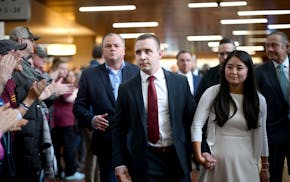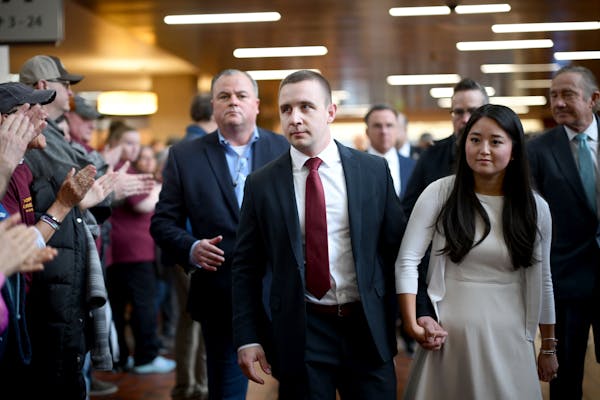LITTLE FALLS, Minn. – Just a day after he had shot two teenagers dead in his home, Byron Smith spoke with calm precision and polite cooperation as he explained to a sheriff's sergeant that fear and a series of thefts drove him to fire the fatal shots.
In a recorded interview played for jurors in the opening day of his murder trial Monday, Smith described how he assumed the intruders were thieves who had been targeting him, stealing thousands in cash and a couple of his guns. He decided, he said, that it was shoot or be shot.
"I was far over the edge," Smith said. "I was reacting."
Smith, now 65, sat quietly in the Morrison County courtroom Monday, dabbing his reddened face with a tissue.
More than a year after the Thanksgiving Day break-in and shootings made him a potent symbol in the national debate over the rights of homeowners to defend their property and families, a rural Minnesota jury must decide if Smith was a beleaguered victim or calculating killer. Smith is claiming he was defending himself and his home when he shot 18-year-old Haile Kifer and 17-year-old Nick Brady after they broke into his house in 2012. Prosecutors say he crossed the legal line into murder when he continued to shoot after each unarmed intruder was wounded and no longer posed a threat. They contend Smith was a vigilante waiting in ambush for the teens.
In the interview recording with Morrison County Sheriff's Sgt. Jeremy Luberts, Smith talked about being hounded by the thefts and how he thought the neighbor's daughter was in on them.
Sitting in his favorite basement reading chair with a paperback that day, Smith said he got "seriously stressed" when he heard someone rattle the door handles to his house and saw a shadow through a picture window.
Soon, he heard a window break, then he heard someone walking upstairs and when the intruder descended, Smith saw feet, legs, then hips and shot twice. The intruder fell face up, Smith could see it was a male.
Then, "I shoot him in the face. I want him dead," Smith told the sergeant. He put the bloody body on a tarp and dragged it into a basement workshop to keep from staining his basement carpet, he said.
'Ganging up on me'
He reloaded his rifle and sat again. He tried to calm down, but blood was pounding in his ears and he heard more footsteps upstairs and feared, "they're ganging up on me," he told Luberts.
He shot the next intruder, wearing a black hoodie tightly drawn to her face, in much the same way. She tumbled down the stairs, too.
"My thinking was, I'm not going to ask if there's a gun," he said. He pulled the trigger to shoot her again, he said, but when the gun clicked in a misfire, he heard her laugh at him. He pulled out another gun and shot more.
"Yes I fired more shots than I needed to," he told Luberts, adding that he was feeling threatened and "I was no longer willing to live in fear."
When the female stopped moving, he dragged her by her clothes and into the workshop, too. There, he said, he noticed she was still gasping and didn't believe she should suffer, so he gave her "a good clean finishing shot," he said. "She gave out the death twitch."
Questioned about why he had continued to shoot, Smith explained that he was afraid the intruders would get up again and he didn't want to wait for them to pull out weapons.
"I wasn't looking at her hands," he explained, adding that he believed they were gun thieves. "As far as I was concerned they were totally dangerous."
His voice cracked on the recording as he talked about spending 20 years overseas and never having any problems like he was having in his hometown.
Smith said he ended up hiding in the basement through the night and into the next morning before calling a neighbor because he was afraid of an accomplice. He thought the neighbor girl's father might come looking for her, he said.
"The first couple hours I was just shaking and I gradually shifted into worrying," he said. "I was pretty much afraid to do anything."
He also realized the incident was over — the intruders were dead — and nothing was going to change by waiting, he said.
"I saw it as a static situation," he told police. He said he also thought for a bit that although his Thanksgiving was ruined, he didn't have to ruin it for others by calling authorities that day.
Was it reasonable?
Smith later volunteered to give his fingerprints, agreed to give a sample of his DNA and explained to authorities how they could access the video surveillance he had installed on the exterior of his house.
Jurors will have to decide whether Smith, who faces life in prison if convicted of first-degree murder, acted reasonably that day.
Minnesota law allows a person to take a life to avert death or great bodily harm, or to prevent a felony in his or her home. Juries are instructed to consider the circumstances and whether it was a decision "a reasonable person would have made in light of the danger perceived."
Opening statements
In opening statements Monday morning, prosecutor Brent Wartner portrayed Smith as a vigilante who sat waiting in his basement in the chair tucked between two bookcases, with loaded weapons, water and food.
He highlighted that Smith had an audio recorder running for six hours before, during and after the shootings. Wartner claimed Smith waited before calling anyone because he "wanted to be ready" for when he thought the neighbor girl's father would come looking for her.
Defense attorney Steve Meshbesher said Smith shot the two teens — that is not in dispute — but that Smith is not guilty of murder for doing it. He outlined Smith's life history, including his years in the military, his work with Scouts and later his employment with the U.S. State Department.
"This case is a tragedy, make no mistake about it. There are two people who are dead and I will not attempt to de-emphasize or downplay that reality," Meshbesher said.
"Mr. Smith is the person who shot and killed those two people, but he is not criminally responsible for their deaths."
Pam Louwagie • 612-673-7102

Supporters rally at courthouse as Minnesota state trooper appears for murder hearing
Metro Transit expanding fleet of electric buses in 'crucial' step toward environmental goal

